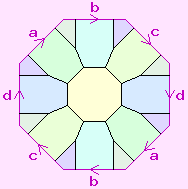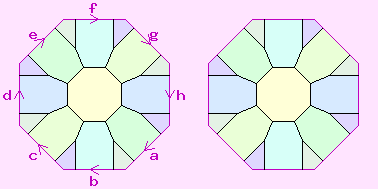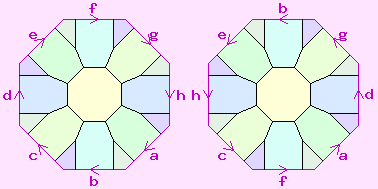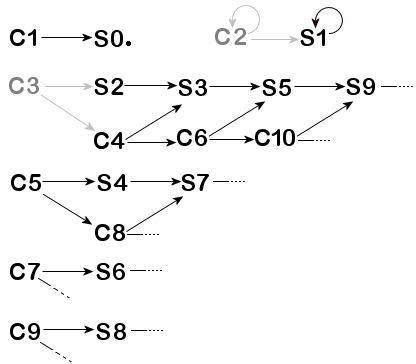A double cover is a non-symmetric relationship which is seen between some pairs of regular maps.
A regular map B is a double cover of a regular map A if and only if there is a set of 2-to-1 mappings from the vertices of B to the vertices of A, from the faces of B to the faces of A, and from the edges of B to the edges of A which together preserve all the incidences of vertices, edges, and faces; i.e. if an edge of B is incident to a vertex of B, then the mapings take them to an edge of A and a vertex of A that it is incident to, etc.

If we start with a regular map A, and it is drawn on a polygon, we may be able to construct a double cover of it as follows. As an example, start with S2:{8,3}, as seen to the right.

Now place a copy of it alongside it, as seen below to the right. Remove the labelling on the sides of the right octagon (we have not yet decided how to match it up to the left octagon), and label the sides of the left octagon with eight different letters.
Now find a way of matching up the edges so that what we have is a regular map. There may appear to be a lot of possiblities, but in fact there aren't very many. For example, in the diagram we see four half-faces coloured lime green. All four must map to a single face of the S2:{8,3} we are building a double cover of, so if we join the lower lime green half-face of the left octagon to the lower lime green half-face of the right octagon, we are forced also to join the upper green half-faces. Moreover, if all the arrows go the same way around the left octagon, they must also all go the same way around the right octagon (otherwise we would have a non-orientable surface). These arguments reduce the possibilities to be tried to 32; they can probably be reduced still further.

We find, in this case, that we can achieve a regular map. Shown to the right, it is S3:{8,3}, also known as the Dyck Map.

If B is a double cover of A, its Euler characteristic must be twice that of A's. For example, as we saw above, a regular map in orientable genus 3 can be a double cover of a regular map in orientable genus 2. This tells us which surfaces can cover which — the possibilities, for the surfaces of lowest genera, are shown in the diagram to the right.
Some points about the diagram:
Triple covers, and higher-degree covers, are similarly defined, using n-1 mappings instead of 2-1 mappings.